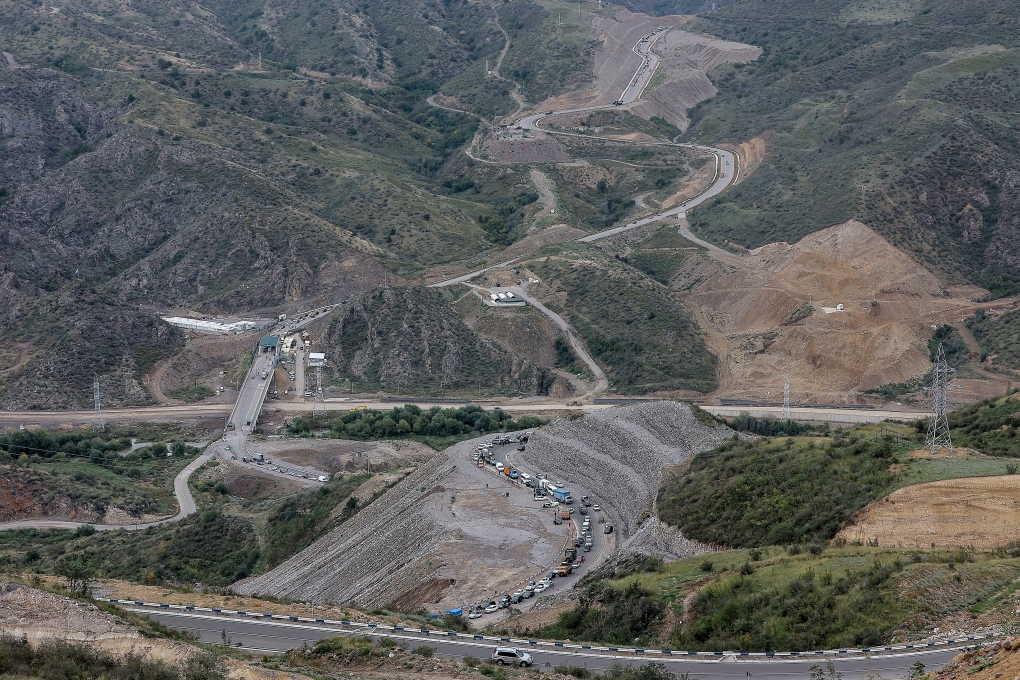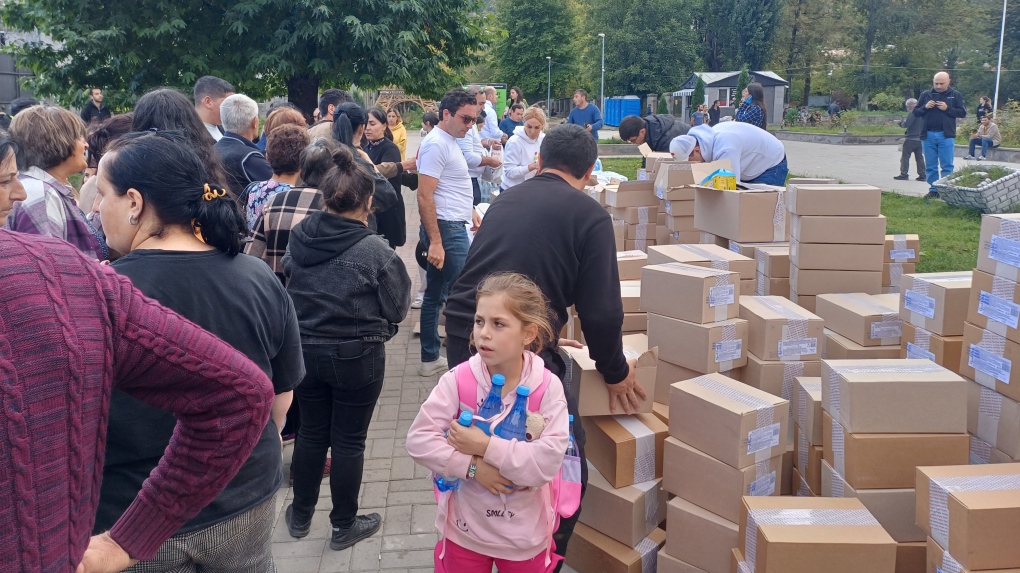
'Cybersecurity incident' shuts down London Drugs stores across Western Canada
All 79 locations of pharmacy and retail chain London Drugs were shut down Sunday after it was the victim of a “cybersecurity incident.”
It’s the kind of scene that many had hoped were confined to history -- particularly those caught up in them now.
For the past five days, vehicles laden with refugees have poured into Armenia, fleeing from the crumbling enclave of Nagorno-Karabakh in neighbouring Azerbaijan. Driving down the Lachin corridor, the only road linking the territory with Armenia and the outside world, they come packed in whatever vehicles they could find.
 A convoy of cars of ethnic Armenians from Nagorno-Karabakh move via Lachin corridor to Kornidzor in Syunik region, Armenia, Tuesday, Sept. 26, 2023. (AP Photo/Vasily Krestyaninov)
A convoy of cars of ethnic Armenians from Nagorno-Karabakh move via Lachin corridor to Kornidzor in Syunik region, Armenia, Tuesday, Sept. 26, 2023. (AP Photo/Vasily Krestyaninov)
Cars hold five or six people each, suitcases strapped to the top, while lorries carry stragglers in their open-air cargo beds. Some even arrive on tractors, now their owners’ most valuable possessions.
Of Nagorno-Karabakh’s 120,000 residents, more than 84,000 have since left to Armenia. All of them are leaving their homes and lives behind. Few believe there will ever be any return.
The present crisis has roots stretching back decades, as well as a much more proximate cause. When the internal borders of the Soviet Union were drawn a century ago, Nagorno-Karabakh, despite its overwhelmingly ethnic Armenian population, was placed inside Soviet Azerbaijan. All part of the same country, these borders mattered little -- until they did.
With the Soviet Union crumbling in the late 1980s, the Armenians of Nagorno-Karabakh agitated to be joined with their ethnic kin in Armenia itself. Azerbaijan refused, violently. In the ensuing war, ethnic Armenians came to control not only Nagorno-Karabakh itself but several neighbouring regions of Azerbaijan proper, declaring their own, unrecognized independent state.
That status quo held from 1994 until 2020. Three years ago, Azerbaijan struck back, seizing three-quarters of the land held by the Armenians of Nagorno-Karabakh. Russia brokered a ceasefire and sent its peacekeepers to uphold it. But over the past year-and- a-half, with Moscow both weakened by its war on Ukraine and growing closer to Baku, Azerbaijan pushed the ceasefire’s limits. It blockaded the only road linking Nagorno-Karabakh to the outside world in December, leading to a nine-month siege in which the territory’s 120,000 civilians were pushed into starvation.
Then, last week it struck the finishing blow, launching a 24-hour military offensive that displaced thousands and pushed Nagorno-Karabakh’s government to unconditionally surrender. As part of that surrender, Karabakh’s Armenians were forced to lay down arms and disband their army. Their ability to defend themselves gone, few, if any of them are choosing to stay.
 Ethnic Armenians refugees stand with their bags as they return to Stepanakert, the capital of the separatist region of Nagorno-Karabakh, on Tuesday, Nov. 17, 2020. (AP Photo/Sergei Grits)
Ethnic Armenians refugees stand with their bags as they return to Stepanakert, the capital of the separatist region of Nagorno-Karabakh, on Tuesday, Nov. 17, 2020. (AP Photo/Sergei Grits)
“We left Artsakh [the Armenian name for Nagorno-Karabakh] when they told us to give up our weapons and said we couldn’t defend ourselves anymore,” says Vahe, a 26-year old from the eastern town of Martuni. He does not give his last name for fear of Azerbaijani retribution against his family members who have not crossed into Armenia yet.
Like most young men in Nagorno-Karabakh, Vahe was a member of the Artsakh Defence Army, as the territory’s de facto military is -- or rather, was -- known. He took part in the 24-hour war Azerbaijan launched last Tuesday.
“We quickly went to our [military] unit, got our guns, and went to our positions,” he says. “When we got there, the bombing had already started. They said there was a ceasefire, but soon after, the shooting began again,” says Vahe.
Contrary to Azerbaijan’s insistence that “only military targets” were struck during the offensive, Vahe says artillery shelling struck across Martuni.
“The whole city of Martuni, and all the other towns and cities [of Nagorno-Karabakh], were bombed,” he says.
 The distribution of humanitarian aid at Red Cross tents in Goris, Armenia, on Sept. 27, 2023 (Neil Hauer for CTV News)
The distribution of humanitarian aid at Red Cross tents in Goris, Armenia, on Sept. 27, 2023 (Neil Hauer for CTV News)
Vahe’s assertion matches with descriptions of indiscriminate bombardment and war crimes committed by Azerbaijan given by many erstwhile residents of Nagorno-Karabakh. One woman from the village of Sarnaghbyur told the BBC that Azerbaijani shelling of her village killed her two young sons.
Another woman recounted how Azerbaijani soldiers arrived at her village, Vaghuhas, and fired weapons into the air, demanding that all Armenians leave -- the opposite of Azerbaijan’s narrative that the Armenian exodus has been ‘voluntary.’
The casualties in the fighting were high, despite its short duration. Nagorno-Karabakh’s officials have reported at least 190 killed and 360 wounded on their side, although the real number, obscured by a lack of communications and the chaos of the aftermath, is suspected to be far higher. Azerbaijan, meanwhile, officially admits 192 of its servicemen were killed and another 511 wounded.
Many of those displaced now had already lost their homes in the 2020 war. Shura and Arega, an elderly couple who have just arrived in Goris, are one such -- their home village, Mets Tagher, was conquered by Azerbaijan three years ago. All of the inhabitants were either forced out or executed by Azerbaijani troops.
“We went from Mets Tagher to Stepanakert,” says Arega. “Now, we’re going from Stepanakert to Yerevan [Armenia’s capital]. Where is going to be next?” she asks.
It took them 36 hours to pass through the nearly 100 km-long traffic jam leading from Stepanakert to the Armenian border. Like everyone else, they had no access to food, water or medicine on the journey -- Azerbaijan has blocked all international aid organizations from accessing Nagorno-Karabakh and the Lachin road. They were lucky enough to survive the journey -- reports are rife of deaths occurring among the stranded refugees.
The organization of their arrival has held well enough, at least in the short term. Refugees arriving in Goris are registered at the local coordination point, after which many are placed on buses that take them to cities, towns and villages across Armenia. There are still issues -- many families do not yet have long-term housing sorted -- but despite being a developing country of under three million people, Armenia appears to be coping with the influx better than many expected.
 An elderly refugee being helped onto a bus that will take her to her new accommodations in Armenia's northern Tavush province (Neil Hauer for CTV News)
An elderly refugee being helped onto a bus that will take her to her new accommodations in Armenia's northern Tavush province (Neil Hauer for CTV News)
This is all very appreciated by those coming from Nagorno-Karabakh. But it will never replace home.
“We all long for the day we can return to our homeland,” says Vahe. “But we know it will never come about under Azerbaijan.”
Neil Hauer is a Canadian journalist and analyst focused on the Caucasus, Russia and Ukraine

All 79 locations of pharmacy and retail chain London Drugs were shut down Sunday after it was the victim of a “cybersecurity incident.”
Three women diagnosed with HIV after getting 'vampire facial' procedures at an unlicensed medical spa are believed to be the first documented cases of people contracting the virus through a cosmetic procedure using needles.
Elias Lindholm scored 1:02 into overtime and the Vancouver Canucks came all the way back to beat the Nashville Predators 4-3 in Game 4 of their first-round playoff series on Sunday.
One person was killed in a six-vehicle crash on Highway 400 in Innisfil Friday evening.
Aerial photos posted by Chinese state media on Sunday showed wide devastation in part of the southern city of Guangzhou after a tornado swept through the day before, killing five people, injuring dozens others and damaging more than 140 buildings.
Ontario is introducing a suite of measures that will crack down on cellphone use and vaping in schools.
Australia's Prime Minister Anthony Albanese on Monday described domestic violence as a 'national crisis' after thousands rallied around the country against violence toward women.
Rookie goalie Arturs Silovs will start in net for the Vancouver Canucks when they face the Nashville Predators in Game 4 of their first-round playoff series Sunday.
U.S. intelligence officials have determined that Russian President Vladimir Putin likely didn't order the death of imprisoned opposition leader Alexei Navalny in February, according to an official familiar with the determination.

The lawyer for a residential school survivor leading a proposed class-action defamation lawsuit against the Catholic Church over residential schools says the court action is a last resort.
Raneem, 10, lives with a neurological condition and liver disease and needs Cholbam, a medication, for a longer and healthier life.
As if a 4-0 Edmonton Oilers lead in Game 1 of their playoff series with the Los Angeles Kings wasn't good enough, what was announced at Rogers Place during the next TV timeout nearly blew the roof off the downtown arena.
Mounties in Nanaimo, B.C., say two late-night revellers are lucky their allegedly drunken antics weren't reported to police after security cameras captured the men trying to steal a heavy sign from a downtown business.
A property tax bill is perplexing a small townhouse community in Fergus, Ont.
When identical twin sisters Kim and Michelle Krezonoski were invited to compete against some of the world’s most elite female runners at last week’s Boston Marathon, they were in disbelief.
The giant stone statues guarding the Lions Gate Bridge have been dressed in custom Vancouver Canucks jerseys as the NHL playoffs get underway.
A local Oilers fan is hoping to see his team cut through the postseason, so he can cut his hair.
A family from Laval, Que. is looking for answers... and their father's body. He died on vacation in Cuba and authorities sent someone else's body back to Canada.